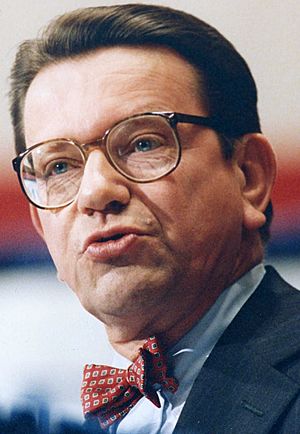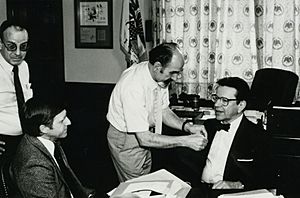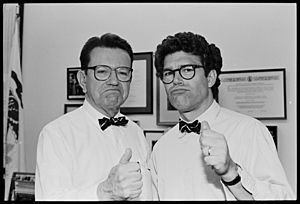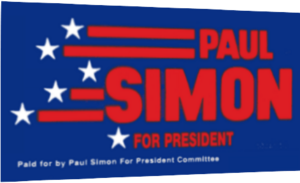Paul Simon (politician) facts for kids
Quick facts for kids
Paul Simon
|
|
|---|---|

Simon in 1989
|
|
| United States Senator from Illinois |
|
| In office January 3, 1985 – January 3, 1997 |
|
| Preceded by | Charles H. Percy |
| Succeeded by | Dick Durbin |
| Member of the U.S. House of Representatives from Illinois |
|
| In office January 3, 1975 – January 3, 1985 |
|
| Preceded by | Kenneth J. Gray |
| Succeeded by | Kenneth J. Gray |
| Constituency | 24th District (1975–1983) 22nd District (1983–1985) |
| 39th Lieutenant Governor of Illinois | |
| In office January 13, 1969 – January 8, 1973 |
|
| Governor | Richard B. Ogilvie |
| Preceded by | Samuel H. Shapiro |
| Succeeded by | Neil Hartigan |
| Personal details | |
| Born |
Paul Martin Simon
November 29, 1928 Eugene, Oregon, U.S. |
| Died | December 9, 2003 (aged 75) Springfield, Illinois, U.S. |
| Resting place | Rowan Cemetery Makanda, Illinois, U.S. |
| Political party | Democratic |
| Spouses |
Jeanne Hurley
(m. 1960; died 2000)Patricia Derge
(m. 2001) |
| Children | 2, including Sheila |
| Education | University of Oregon Dana College |
| Military service | |
| Allegiance | |
| Branch/service | |
| Years of service | 1951–1953 |
| Rank | Private First Class |
| Unit | Counterintelligence Corps |
Paul Martin Simon (born November 29, 1928 – died December 9, 2003) was an American politician and writer from Illinois. He served in the United States House of Representatives from 1975 to 1985. Later, he became a U.S. Senator from 1985 to 1997.
Simon was a member of the Democratic Party. He tried to become president in 1988 but did not win his party's nomination. After his time in politics, he started the Public Policy Institute. This institute is at Southern Illinois University Carbondale and was later named after him. He taught classes there about politics, history, and journalism. Paul Simon was well-known for his unique bowtie and horn-rimmed glasses.
Contents
Early Life and Career Beginnings
Growing Up and Education
Paul Simon was born in Eugene, Oregon, on November 29, 1928. His father, Martin Paul Simon, was a Lutheran minister and a missionary to China. His mother, Ruth Lilly Simon, was also a Lutheran missionary. His family came from Germany.
Simon went to Concordia University in Portland. He also attended the University of Oregon and Dana College in Blair, Nebraska. However, he did not finish college.
Starting a Newspaper
In 1948, Simon borrowed money to buy a newspaper called the Troy Call. He was only 19 years old, making him the youngest editor and publisher in the country. He renamed it the Troy Tribune in Troy, Illinois. Over time, he built a chain of 14 weekly newspapers.
Simon spoke out against gambling and government corruption in his newspaper. This caught the attention of Governor Adlai Stevenson. Simon even testified before the Kefauver Commission, a national group investigating crime.
Military Service
In May 1951, Simon left his newspaper to join the United States Army. He served in West Germany during the Korean War. He worked in the Counterintelligence Corps and reached the rank of Private First Class. He left the Army in June 1953.
Illinois State Politics
Serving in the State Legislature
After his military service, Simon was elected to the Illinois House of Representatives. As a state representative, he strongly supported civil rights. He even hosted an event with former First Lady Eleanor Roosevelt.
During a debate, a newspaper described him as "the man with the bowtie." From then on, he always wore his trademark bowtie and horned glasses.
In 1963, Simon was elected to the Illinois State Senate. He served there until 1969.
Lieutenant Governor of Illinois
In 1969, Paul Simon became the Lieutenant Governor of Illinois. He was a Democrat, but he worked with the Republican Governor, Richard B. Ogilvie. They worked together very well, which was unusual for politicians from different parties.
Their teamwork led to Illinois's first income tax. It also helped create the state's current Illinois Constitution. The Ogilvie-Simon team was the only time in Illinois history that the governor and lieutenant governor were from different parties. Today, the Illinois constitution requires them to run together.
In 1972, Simon ran for governor but lost in the Democratic primary.
National Political Career
In the U.S. House of Representatives

Paul Simon returned to politics in 1974. He was elected to the U.S. House from Illinois's 24th congressional district. He was re-elected four times. Later, his district changed to Illinois's 22nd congressional district.
In 1978, Simon received the first Foreign Language Advocacy Award. This was for his work supporting the study of foreign languages. The New York Times noted that Simon was not always popular with his fellow House members.
Serving in the U.S. Senate
In 1984, Simon ran for the US Senate. He won in an upset election against the long-serving Senator Charles H. Percy. Simon received 50% of the votes.
He won re-election to the Senate in 1990. He defeated U.S. Representative Lynn Morley Martin with 65% of the vote. While in the Senate, he worked with Republican Senator Orrin Hatch on a Balanced Budget Amendment. However, it did not pass.
Simon became more well-known nationally after criticizing President George H. W. Bush in 1992. Bush had claimed a big role in the fall of the Eastern bloc (Soviet Union's allies). Simon disagreed with Bush's claims, and Bush ended up losing Illinois in that election. Simon did not run for re-election in 1996.
Presidential Campaign in 1988
Simon ran for the Democratic nomination for President in 1988. At first, not many people outside Illinois knew him. He was seen as the oldest and most old-fashioned candidate, with his glasses and bowtie. He proudly supported the "New Deal liberalism" ideas of Presidents Franklin Roosevelt and Harry Truman.
Simon became a front-runner in Iowa by late 1987. However, he narrowly lost the Iowa caucus in February 1988. He also did not do well in the New Hampshire primary and other early contests.
Running out of money, Simon focused on his home state of Illinois. He won the Illinois primary. He then tried one last time in Wisconsin but dropped out after finishing behind other candidates. Simon then supported Governor of Massachusetts Michael Dukakis, who won the Democratic nomination.
To help his campaign, Simon appeared on Saturday Night Live (SNL). He co-hosted with the musician Paul Simon (who was not related to him).
Political Beliefs and Actions

Social Issues
In the 1990s, Simon was strongly against violence in the media. His efforts helped lead to the creation of the V-chip. This device allows parents to block TV programs based on their content.
During the 1990s, Simon opposed both the Republicans' "Contract with America" and President Bill Clinton's welfare reforms. He was one of only 21 senators to vote against the Personal Responsibility and Work Opportunity Act. In 1996, Simon and 13 other senators voted against the Defense of Marriage Act. This law prevented the federal government from recognizing same-sex marriage.
Money Matters
Simon was seen as a "fiscal conservative." This means he believed in careful spending of government money. He called himself a "pay-as-you-go Democrat." As a senator, he helped change the college student loan program. This allowed students to borrow money directly from the federal government. This saved money by not using private banks.
World Affairs
Simon supported a military response to problems in Somalia during President George H. W. Bush's time. He also strongly criticized President Bill Clinton's slow response to the 1994 Rwandan genocide. Simon believed America should have acted faster. Clinton later said his slow response was his biggest mistake as president.
Canadian Lieutenant-General Roméo Dallaire thanked Simon for pushing the Clinton administration to help Rwanda during the genocide.
Views on the Presidency
Simon believed that modern presidents often "follow" public opinion polls instead of "leading." He said, "We have been more and more leaning on opinion polls to decide what we're going to do, and you don't get leadership from polls." He felt this was true for senators and other politicians too.
Simon also supported Taiwan and disagreed with the U.S. policy to isolate it. He helped convince President Clinton to allow Taiwanese President Lee Teng-hui to visit the United States.
Personal Life and Legacy
Writing and Teaching
Paul Simon became well-known in the 1960s for his book, Lincoln's Preparation for Greatness. This book carefully researched Abraham Lincoln's years in the Illinois legislature. It was the first book to use original documents from that time. Simon went on to write more than 20 books on many topics. These included books about interfaith marriages, global water shortages, and his own life story. His last book, Our Culture of Pandering, came out two months before he died.
After his 1972 defeat for governor, Simon started a graduate program at Sangamon State University. This program, called Public Affairs Reporting, helped more than 500 journalists start their careers. Simon also taught writing and at the John F. Kennedy School of Government at Harvard University.
Simon lived for many years in Makanda, Illinois. There, he was a professor and director of the SIU Public Policy Institute. He wanted the institute to help improve people's lives. Activities included monitoring elections in Liberia and Croatia. He also brought important speakers to campus. He spoke out against the death penalty and tried to end the United States embargo against Cuba. He also wanted to change the United States Constitution to end the electoral college.
Family Life
Paul Simon' was the brother of Arthur Simon, who founded the organization Bread for the World.
On April 21, 1960, Simon married Jeanne Hurley Simon. She was also a member of the Illinois state legislature. It was the first time in Illinois history that two sitting lawmakers got married. Jeanne was a big part of her husband's success. She later became a successful lawyer, author, and leader of the National Commission on Libraries and Information Science. She passed away in February 2000 from brain cancer.
Their daughter, Sheila Simon, became the Lieutenant Governor of Illinois in 2011. She had also served as a councilwoman in Carbondale, Illinois and was a law professor.
In May 2001, Simon married Patricia Derge.
Pop Culture
Simon appeared on Saturday Night Live with the singer Paul Simon (no relation) in December 1987. On SNL, comedian Al Franken often played Paul Simon. Franken later became a senator himself.
Awards and Recognition
Paul Simon was honored as a Laureate of The Lincoln Academy of Illinois in 1998. He received the Order of Lincoln, which is Illinois's highest honor, for his work in government. In 1999, he received the Richard Nelson Current Award of Achievement.
Death and Aftermath
Paul Simon passed away in Springfield, Illinois, on December 9, 2003, at age 75. He had heart surgery. Just four days before, even from his hospital bed, he had supported Howard Dean's presidential campaign. He also supported Barack Obama's run for the U.S. Senate in 2004.
After Simon's death, his daughter, Sheila, made a TV ad. She said, "Barack Obama will be a U.S. Senator in the Paul Simon tradition." This ad was a big reason for Obama's win in the Democratic primary. In the Senate, Obama spoke highly of Simon, calling him a "dear friend."
In July 2005, the Paul Simon Historical Museum opened in Troy, Illinois. Simon had lived there for 25 years. The museum showed items from his life, like his desk from his newspaper days and things from his presidential campaign. The museum closed in 2012 due to lack of money.
The Paul Simon Chicago Job Corps is a government-funded school named after him. It is in Chicago and helps young people aged 16-24 build a positive future.
See also
In Spanish: Paul Simon (político) para niños


